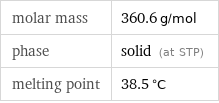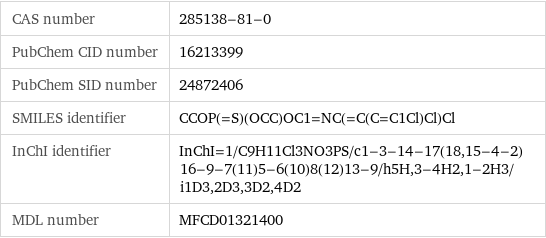Input interpretation

chlorpyrifos-diethyl-d 10
Chemical names and formulas
![formula | C_5NHCl_3OP(OCD_2CD_3)_2 Hill formula | C_9HD_10Cl_3NO_3PS name | chlorpyrifos-diethyl-d 10 IUPAC name | bis(1, 1, 2, 2, 2-pentadeuterioethoxy)-thioxo-[(3, 5, 6-trichloro-2-pyridyl)oxy]phosphorane alternate names | bis(1, 1, 2, 2, 2-pentadeuterioethoxy)-sulfanylidene-(3, 5, 6-trichloropyridin-2-yl)oxy-phosphorane | bis(1, 1, 2, 2, 2-pentadeuterioethoxy)-sulfanylidene-(3, 5, 6-trichloropyridin-2-yl)oxyphosphorane | bis(1, 1, 2, 2, 2-pentadeuterioethoxy)-thioxo-[(3, 5, 6-trichloro-2-pyridyl)oxy]phosphorane mass fractions | Cl (chlorine) 0.295% | S (sulfur) 0.0889% | P (phosphorus) 0.0859% | O (oxygen) 0.133% | N (nitrogen) 0.0388% | C (carbon) 0.3% | H (hydrogen) 0.0586%](../image_source/18482791fcd014722e9d7beb0a4c753b.png)
formula | C_5NHCl_3OP(OCD_2CD_3)_2 Hill formula | C_9HD_10Cl_3NO_3PS name | chlorpyrifos-diethyl-d 10 IUPAC name | bis(1, 1, 2, 2, 2-pentadeuterioethoxy)-thioxo-[(3, 5, 6-trichloro-2-pyridyl)oxy]phosphorane alternate names | bis(1, 1, 2, 2, 2-pentadeuterioethoxy)-sulfanylidene-(3, 5, 6-trichloropyridin-2-yl)oxy-phosphorane | bis(1, 1, 2, 2, 2-pentadeuterioethoxy)-sulfanylidene-(3, 5, 6-trichloropyridin-2-yl)oxyphosphorane | bis(1, 1, 2, 2, 2-pentadeuterioethoxy)-thioxo-[(3, 5, 6-trichloro-2-pyridyl)oxy]phosphorane mass fractions | Cl (chlorine) 0.295% | S (sulfur) 0.0889% | P (phosphorus) 0.0859% | O (oxygen) 0.133% | N (nitrogen) 0.0388% | C (carbon) 0.3% | H (hydrogen) 0.0586%
Lewis structure

Draw the Lewis structure of chlorpyrifos-diethyl-d 10. Start by drawing the overall structure of the molecule, ignoring potential double and triple bonds: Count the total valence electrons of the carbon (n_C, val = 4), chlorine (n_Cl, val = 7), hydrogen (n_H, val = 1), nitrogen (n_N, val = 5), oxygen (n_O, val = 6), phosphorus (n_P, val = 5), and sulfur (n_S, val = 6) atoms: 9 n_C, val + 3 n_Cl, val + 11 n_H, val + n_N, val + 3 n_O, val + n_P, val + n_S, val = 102 Calculate the number of electrons needed to completely fill the valence shells for carbon (n_C, full = 8), chlorine (n_Cl, full = 8), hydrogen (n_H, full = 2), nitrogen (n_N, full = 8), oxygen (n_O, full = 8), phosphorus (n_P, full = 8), and sulfur (n_S, full = 8): 9 n_C, full + 3 n_Cl, full + 11 n_H, full + n_N, full + 3 n_O, full + n_P, full + n_S, full = 166 Subtracting these two numbers shows that 166 - 102 = 64 bonding electrons are needed. Each bond has two electrons, so in addition to the 29 bonds already present in the diagram we expect to add 3 bonds. To minimize formal charge sulfur wants 2 bonds, nitrogen wants 3 bonds, and carbon wants 4 bonds. Identify the atoms that want additional bonds and the number of electrons remaining on each atom: Add 3 bonds by pairing electrons between adjacent highlighted atoms. Additionally, atoms with large electronegativities can minimize their formal charge by forcing atoms with smaller electronegativities on period 3 or higher to expand their valence shells. The electronegativities of the atoms are 2.19 (phosphorus), 2.20 (hydrogen), 2.55 (carbon), 2.58 (sulfur), 3.04 (nitrogen), 3.16 (chlorine), and 3.44 (oxygen). Because the electronegativity of phosphorus is smaller than the electronegativity of sulfur, expand the valence shell of phosphorus to 5 bonds. Therefore we add a total of 4 bonds to the diagram. Note that the six atom ring is aromatic, so that the single and double bonds may be rearranged: Answer: | |
Basic properties

molar mass | 360.6 g/mol phase | solid (at STP) melting point | 38.5 °C
Units

Non-standard atom properties

H-2 | 10
Chemical identifiers

CAS number | 285138-81-0 PubChem CID number | 16213399 PubChem SID number | 24872406 SMILES identifier | CCOP(=S)(OCC)OC1=NC(=C(C=C1Cl)Cl)Cl InChI identifier | InChI=1/C9H11Cl3NO3PS/c1-3-14-17(18, 15-4-2)16-9-7(11)5-6(10)8(12)13-9/h5H, 3-4H2, 1-2H3/i1D3, 2D3, 3D2, 4D2 MDL number | MFCD01321400